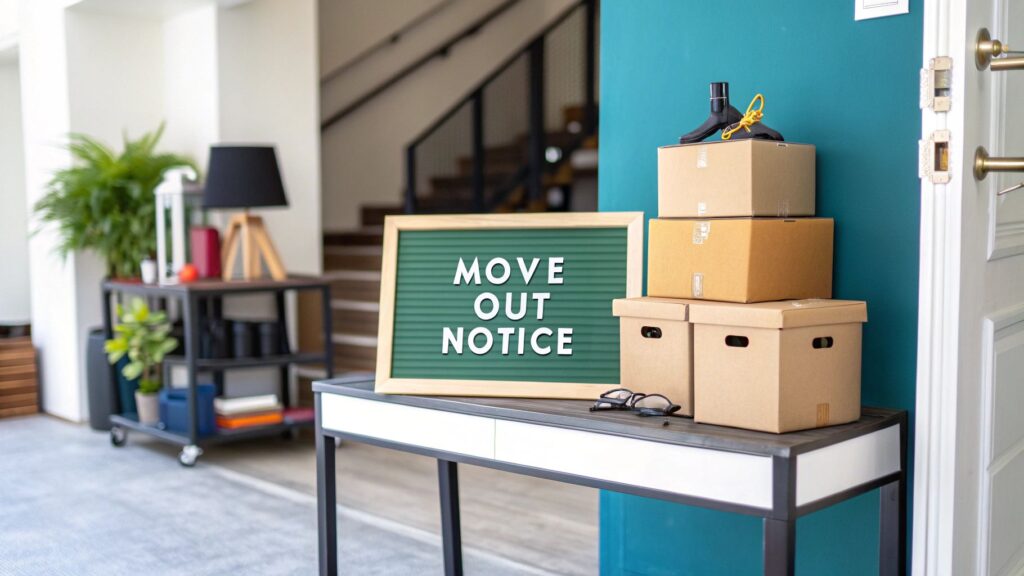Before you even think about packing, the very first thing you need to do is pull out your lease agreement. This document is your playbook for moving out correctly, and ignoring it can be a costly mistake. It will tell you exactly how much notice you need to give, which is usually 30, 60, or 90 days.
Find and Understand Your Lease's Move-Out Clause
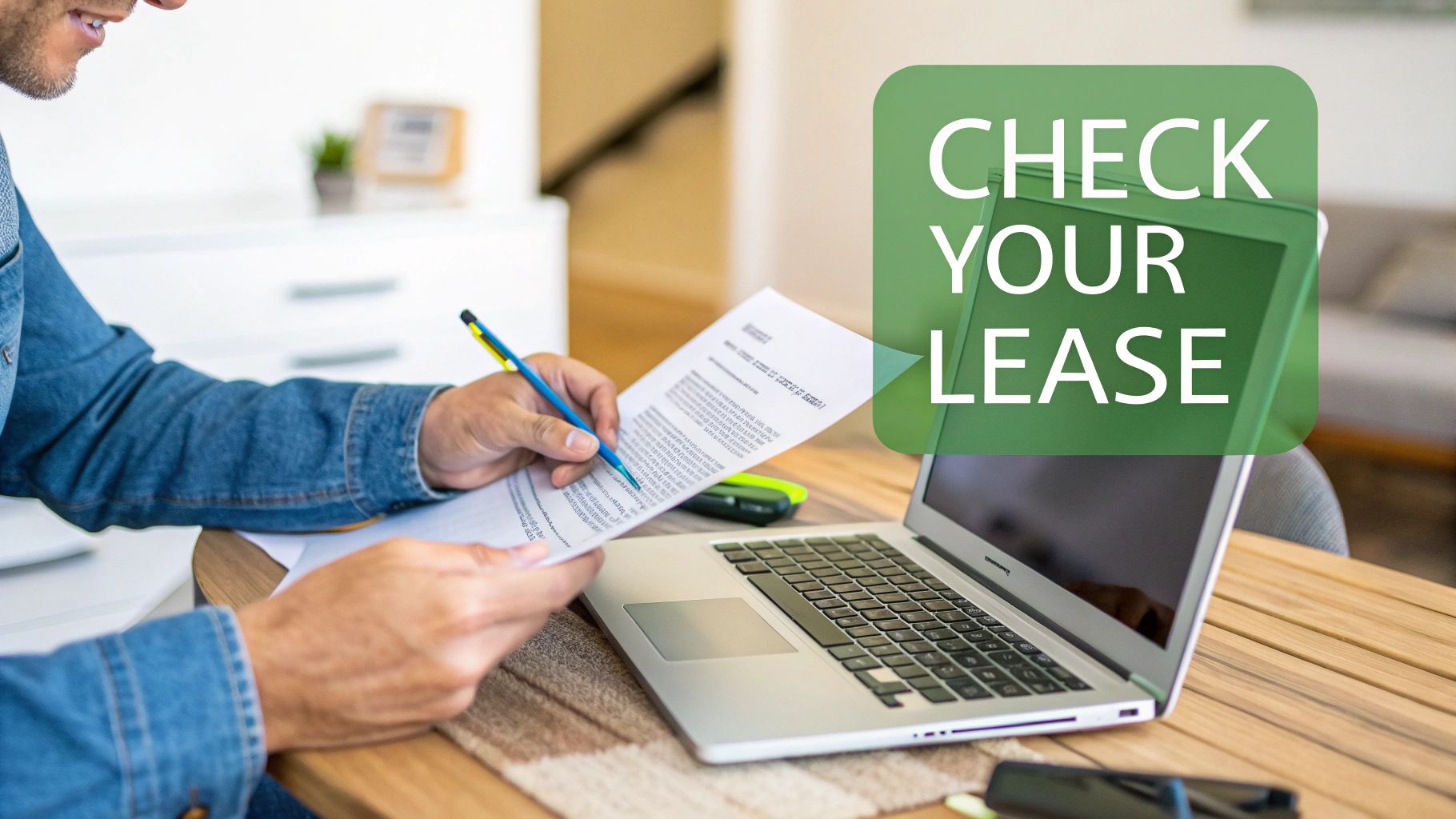
Somewhere in that legal jargon is a section that is often called "Notice to Vacate" or "Termination." This is the most important part of the document right now. It spells out precisely how much warning you must give your landlord before you leave.
Getting this timeline wrong isn't a minor slip-up. For instance, if your lease demands a 60-day notice but you only give 45 days, your landlord could legally require you to pay for that full 60-day period, even after you've moved out. That’s an expensive oversight.
Fixed-Term vs. Month-to-Month: What's the Difference?
The type of lease you signed drastically changes the rules. If you have a standard one-year lease, you still have to give notice that you aren't renewing. Don't assume your landlord knows you're leaving just because the end date is approaching.
If you've shifted to a month-to-month agreement after your initial lease ended, the notice period is often shorter—typically 30 days. But again, you have to check the original lease to be sure. For a deeper dive into these details, our guide on https://cynthiagardens.com/a-lease-agreement/ can help clear things up.
The most important takeaway here? Never rely on a verbal agreement or an assumption. Your lease is a binding contract, and following its written move-out rules is the only way to protect yourself and your security deposit.
Interestingly, with the current rent gap favoring existing tenants, more people are staying put. Recent data shows that 47% of renters planned to stay in their homes from mid-2024 to mid-2025. This makes it even more critical to handle your move-out properly when you finally decide to leave.
It's also a good idea to understand how your lease fits within the broader legal landscape. Brushing up on local regulations, like the Texas lease agreement laws, gives you a complete picture of your rights and responsibilities.
Writing a Clear and Professional Notice to Vacate
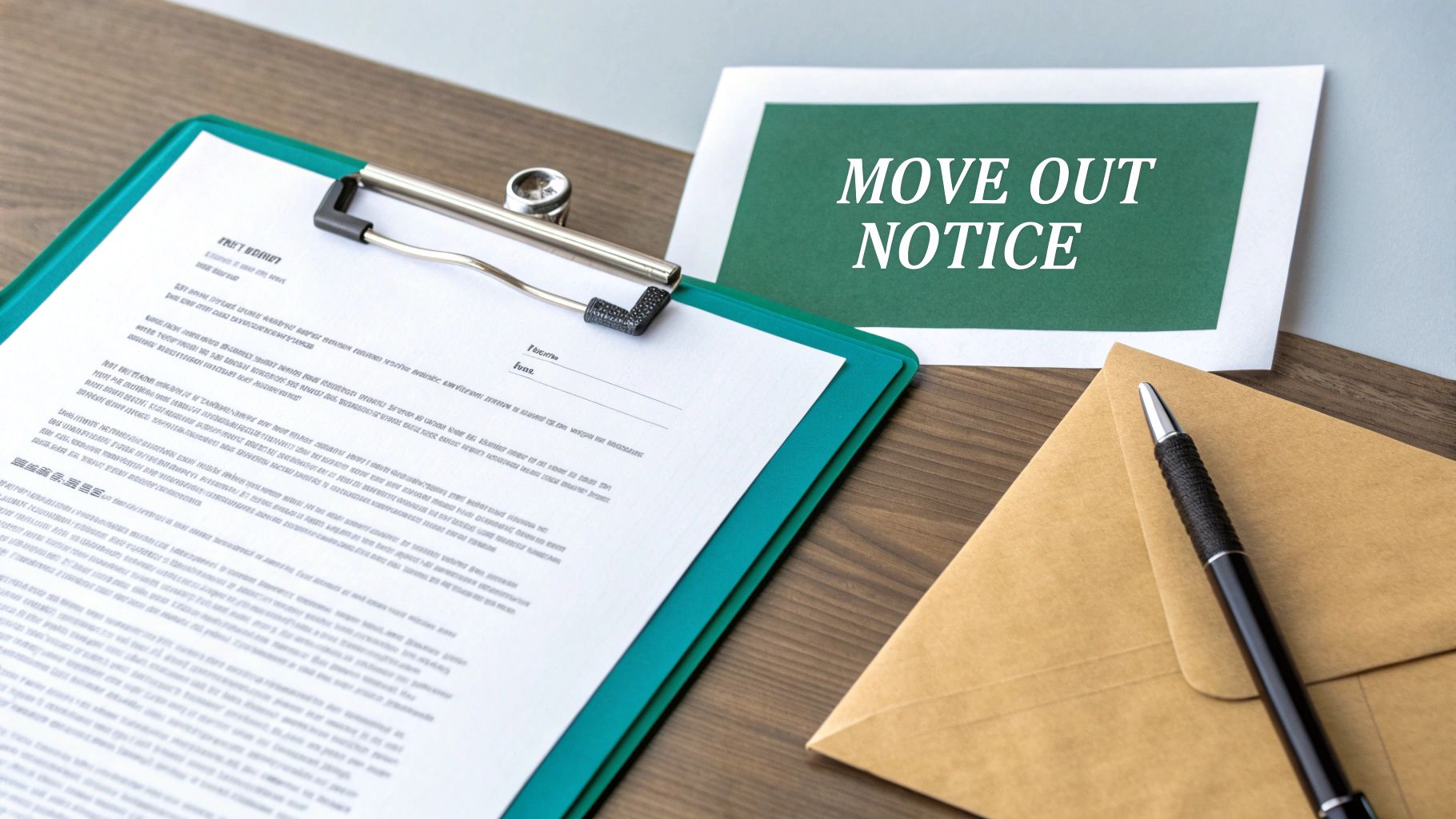
Putting together your move-out notice shouldn't be stressful. The best approach is to treat it like a straightforward business letter—polite, direct, and packed with all the crucial details. Your main goal here is to create a crystal-clear, official record of your plan to leave, leaving no room for misunderstandings down the road.
Before you get into the meat of it, cover the basics. Start with the current date at the very top. Right below that, add your full name and complete apartment address, making sure to include your unit number. This immediately signals to your landlord who the notice is from and which specific unit it applies to.
Then, address the letter directly to your landlord or property management company. Using their proper name and address adds a professional touch and helps ensure your notice gets to the right hands without delay.
Stating Your Intentions Clearly
This is the most important part of the letter: your statement of intent. You don’t need to get fancy here. In fact, a simple, direct sentence is the most powerful way to communicate your plans. State clearly that you will be vacating the property and provide the exact date your lease will terminate.
That final date is the single most critical piece of information in the entire document. For example, if you're providing a 60-day notice on May 1st, your last day in the apartment would be June 30th. Pinpointing this date removes any ambiguity about when your responsibilities for the unit (and the rent) officially end.
Keep in mind, the right tone is respectful but firm. You're not asking for permission to move out; you're fulfilling your legal obligation to notify your landlord. Maintaining a professional tone helps ensure your tenancy ends on good terms.
The Essential Elements of Your Notice
When it comes down to it, your notice to vacate is a legal document. Missing a key piece of information can cause delays, confusion, or even financial headaches. To make sure you've covered all your bases, I've put together a checklist of the essential components.
Use this table as a final review before you send your notice. It breaks down what you need, why it matters, and provides some simple wording to get you started.
| Component | Why It's Critical | Example Wording |
|---|---|---|
| Current Date | Establishes the official start of your notice period. | "Date: March 15, 2024" |
| Your Full Name & Address | Clearly identifies you and the specific rental unit. | "From: Jane Doe, 123 Main Street, Apt. 4B" |
| Landlord's Name & Address | Ensures the notice is delivered to the correct person/entity. | "To: Mr. John Smith, Smith Property Management, 456 Oak Avenue" |
| Clear Statement of Intent | Leaves no room for misinterpretation of your plan to move. | "This letter serves as my official notice to vacate the premises." |
| Specific Move-Out Date | Defines the exact end of your tenancy and rent responsibility. | "My tenancy will terminate on May 31, 2024." |
| Forwarding Address | Tells your landlord where to mail your security deposit refund. | "My security deposit can be mailed to my new address: 789 Pine Lane…" |
| Request for Inspection Info | Shows you're proactive and helps you protect your deposit. | "Please let me know when we can schedule a final move-out inspection." |
| Your Signature | Makes the document legally valid and official. | Your handwritten or legally accepted digital signature |
Checking these boxes ensures your notice is complete and professional, which is your first step toward a smooth move-out and getting that security deposit back in full.
Choosing the Right Way to Deliver Your Notice
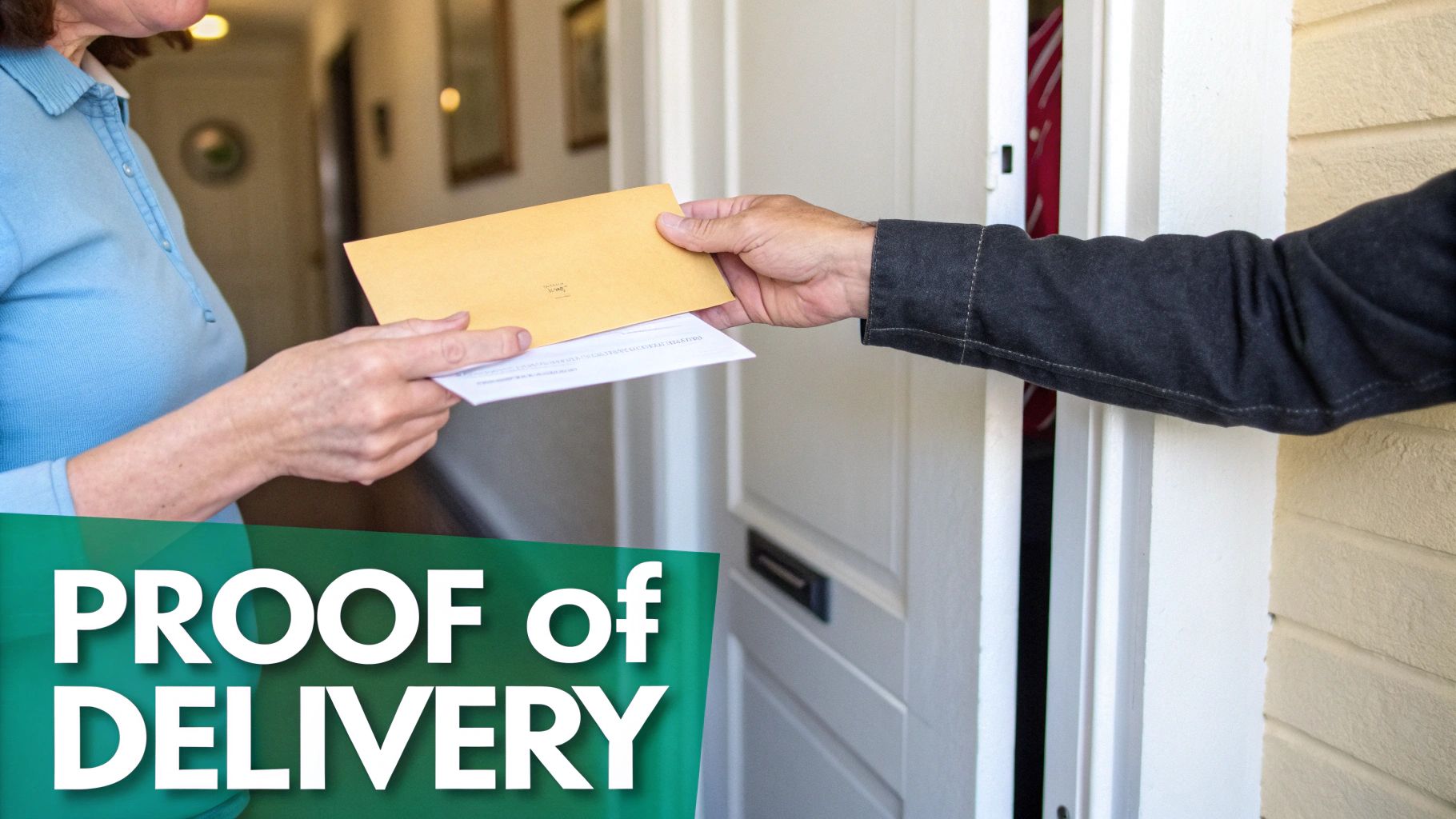
You can write the most flawless move-out notice in the world, but it’s completely useless if it never officially lands in your landlord’s hands. How you deliver your notice is just as critical as what’s in it—this is what creates the official record.
If you can’t prove your landlord got the notice on time, you could be on the hook for another month's rent. It happens more often than you'd think.
For absolute peace of mind, the gold standard is sending your letter via certified mail with a return receipt requested. It gives you a tracking number, but the real prize is the signature confirmation that gets mailed back to you once your landlord accepts the letter. That little green card is your ironclad proof of delivery, a lifesaver if any disputes come up later.
In-Person and Digital Delivery Options
Handing your notice directly to your landlord or property manager is another great option, but you have to be smart about it. Don't just leave it on a desk or slide it under a door.
When you deliver it in person, always ask for a signed and dated receipt. It doesn't need to be fancy—a quick note on a copy of your letter that says "Received on [Date]" with their signature is all you need to protect yourself.
So, what about email? It's fast and easy, but it can be risky. Only use email if your lease specifically says it's an acceptable method for official notices. Even then, you need to be proactive.
A few hours after you send the email, follow up with a polite phone call or a second email asking them to confirm they got it. A simple reply from your landlord saying, "Got it, thanks!" is crucial for your records. Never assume they saw it just because you clicked "send."
Ultimately, your lease agreement is your guide. But if you have a choice, weigh your options carefully.
- Certified Mail: This is your safest bet. It's the most secure, legally-binding option with undeniable physical proof of receipt.
- Hand Delivery: A solid, immediate choice, but only if you walk away with a signed, dated receipt in your hand.
- Email: Convenient, but only an option if your lease allows it, and you absolutely must get a confirmation reply.
Picking the right delivery method gets your notice officially on the record. This simple step protects you from penalties and is a key part of making sure you get your full security deposit back.
Common Mistakes That Can Cost You Money
https://www.youtube.com/embed/-2pJm8ifemc
Giving your landlord notice that you’re moving out sounds simple enough. But I’ve seen small, easy-to-avoid slip-ups turn into major financial headaches for tenants who just didn’t know any better. Many people learn the hard way that a casual chat or a quick text isn't enough to legally end a tenancy.
Let's dive into the mistakes that could really cost you.
Getting the Timing and Format Wrong
The single most common error is getting the notice period wrong. If your lease demands 60 days' notice and you only give 45, you’re likely on the hook for another full month of rent. It’s not a penalty—it’s just you fulfilling the contract you signed.
And that verbal "heads-up" you gave your landlord last month? It offers zero legal protection if a dispute comes up later. Always, always, always get it in writing.
Forgetting to Document Everything
Another expensive mistake is failing to document the apartment's condition right before you leave. Without proof, it's just your word against your landlord's when it comes to supposed damages. That’s a weak position to be in.
The absolute best way to protect yourself is with a thorough photo and video walkthrough just before you hand over the keys for the last time.
- Go room by room: Take clear, well-lit pictures of every wall, floor, and ceiling. Open closets and capture the inside.
- Focus on the details: Get close-ups of areas that are frequent battlegrounds for deposits—carpets, countertops, blinds, and appliances.
- Shoot a video: A slow, narrated video walkthrough is powerful evidence. As you film, open cabinets and drawers, turn on faucets, and show that appliances are clean and working. This proves you left the place in good shape.
Remember, a landlord can only deduct for damages that go beyond normal wear and tear, not for things like routine painting or carpet cleaning after years of use. Understanding what a security deposit is and what it legally covers is your best defense against unfair charges.
Underestimating the Final Clean-Up
Don't just assume you know what "clean" means to your landlord. Your lease probably has a section detailing exactly how the apartment should be left. Skimming over this can lead to hundreds of dollars in professional cleaning fees being taken straight from your deposit.
Broader economic factors can also impact why people move. For example, rental markets in places like the Northeast are seeing moderate rent increases tied to job growth in certain sectors. These trends directly influence how often tenants decide it's time to move on. You can learn more about how corporate housing outlooks affect rental trends on AvenueWest.com.
What To Do After You’ve Sent Your Notice
Once your move-out notice is officially in your landlord's hands, the clock starts ticking. This isn't the time to sit back and relax; it’s time to kick your move-out plan into high gear. The next few weeks are all about smart coordination to make sure you have a smooth exit, protect your good standing as a tenant, and get as much of your security deposit back as possible.
The first thing you should do is call your landlord or property manager to get the final move-out inspection on the calendar. Taking the initiative here shows you're serious about leaving the apartment in great condition. Try to schedule it for a time when you can be there in person. This lets you walk through the unit with them and clear up any potential issues right then and there.
Next up, tackle your utilities. Get in touch with your providers for electricity, gas, internet, and water to schedule a service cutoff or transfer. A pro tip: set the date for the day after you’re completely moved out. You don’t want to be stuck cleaning in the dark or accidentally pay for the next tenant's hot water.
Focus on a Thorough Deep Clean
Leaving your apartment looking immaculate is the single best way to secure your full deposit. Landlords have a knack for spotting the places tenants forget, so you’ll want to focus on the details.
Here’s a quick-hit list of what to focus on:
- Kitchen Appliances: Don’t just wipe them down. Clean inside the oven, microwave, and fridge. If you can, pull them away from the wall to get all the dust and grime that builds up behind and underneath.
- Bathrooms: Go to war with soap scum in the shower, scrub the grout until it’s clean, and make sure the mirrors, faucets, and fixtures shine.
- The Overlooked Spots: It's easy to forget baseboards, the blades of ceiling fans, light fixtures, and the insides of every cabinet and drawer. Your landlord won't.
To really cover all your bases and maximize your chances of getting that full security deposit back, it’s a great idea to consult an ultimate end of tenancy cleaning checklist to guide your efforts.
Your objective is simple: return the apartment to the same condition you found it in, allowing for normal wear and tear. Taking a few photos after you've cleaned is solid proof of your hard work.
Sometimes, even with the best plans, things change. If you find you need to leave earlier than you originally told your landlord, you might want to learn more about the possibility of an apartment lease buyout.
Common Questions About Giving Notice
When it's time to move, most renters run into the same handful of questions. Getting your apartment move-out notice right is a big deal, and knowing the answers to these common sticking points will help you handle the process like a pro.
What Happens If I Miss My Notice Deadline?
This is a classic "oops" moment, and it can be costly. If you miss the notice deadline outlined in your lease, you're usually on the hook for the next month's rent, even if you're not living there.
Often, your lease will automatically roll over to a month-to-month agreement. This means you’ll owe rent for a full notice period—typically 30 days—from the day you finally do give notice. My advice? The second you realize you're late, talk to your landlord. They might work with you if they can find a new renter quickly, but legally, they don't have to.
Can a Landlord Actually Refuse My Move-Out Notice?
It’s rare, but it can happen. A landlord generally can't reject a notice that ticks all the boxes required by your lease (like proper timing and delivery).
However, they can push back if your notice is incomplete, doesn't give enough warning, or if you're trying to bail on a fixed-term lease without a legitimate reason.
The best way to avoid any drama is to simply read your lease agreement one more time before sending your notice. A correctly submitted notice is a legally binding document that protects you, so make sure it's solid.
Once your notice is accepted, the real moving process begins. This timeline breaks down what comes next, from the initial inspection to managing utilities and that final deep clean.
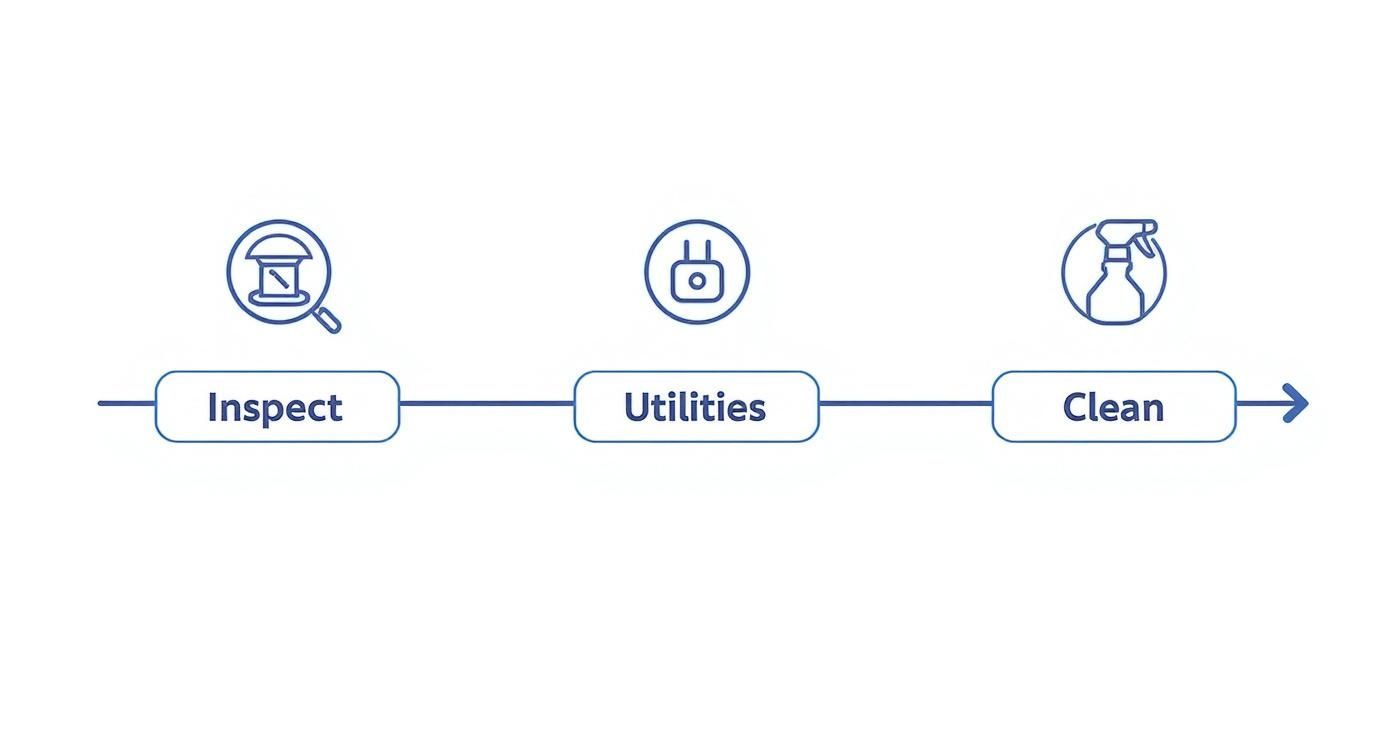
Following these steps is the surest path to a hassle-free move and getting your full security deposit back.
Do I Still Have to Pay Rent for My Last Month?
Yes, absolutely. You are required to pay rent for the entire notice period, right up to your last day. It's a common misconception, but your security deposit cannot be used to cover your final month's rent. Skipping that last payment can seriously damage your rental history and could even lead to legal trouble.
What if I Need to Leave Before My Lease Is Up?
Life happens. If you have to move before your lease ends, this is known as "breaking a lease," and the consequences depend entirely on your rental agreement.
- Check for an early termination clause: Some leases have one, which usually requires you to pay a specific fee to get out early.
- If there's no clause: You might be responsible for paying rent until the landlord finds a new tenant to take over the unit.
The key is communication. The moment you know you need to leave, review your lease and have an honest conversation with your landlord. The more notice you can give, the better.
Ready to find your next home in sunny South Florida? At Cynthia Gardens, we offer beautiful one-bedroom apartments perfect for students and professionals. Check out our available units and see why our residents love living here. Find your perfect Boca Raton apartment at Cynthia Gardens.
